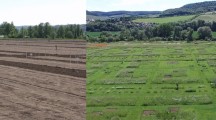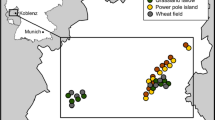Abstract
Agricultural expansion requires mitigation to conserve biodiversity and maintain functional interactions across the transformed mosaic. Conservation outside protected areas (PAs) means providing increased spatial opportunities for populations to survive over the long-term. Here we assess the capacity of agricultural mosaics for maintaining indigenous biodiversity against the benchmark levels in neighbouring PAs. We do this in three geographical areas in the major biodiversity hotspot, the Cape Floristic Region. We focus on two functionally related groups, indigenous flowers and their associated native insects, to assess the biodiversity value of certain components of agricultural mosaics. These components include agriculturally disturbed land, semi-transformed, disturbed land, and remnant patches of natural land, as well as adjacent PAs as reference sites. Overall, species richness across the agricultural mosaics outside PAs was similar to that within PAs for insects, although more variable for plants. Nevertheless, sites outside PAs still retained great diversity of flowering plants. Across the agricultural mosaic, sites shared 20–38 % of their insect species, and 12–28 % of plant species, indicating substantial species turnover. Each particular agricultural component retained species not sampled elsewhere in the landscape, indicating that habitats outside PAs can make a significant contribution to the compositional biodiversity of an area. Our findings are positive for biodiversity conservation across these agricultural mosaics, with these semi-natural components within the production landscape, in effect, extending the size of the PAs for many species. Conservation planning should recognize the value of such agricultural mosaics.




Similar content being viewed by others
References
Ashwell A, Sandwith T, Barnett M, Parker A, Wisani F (2006) Fynbos fynmense: people making biodiversity work, vol 4, SANBI biodiversity seriesSouth African National Biodiversity Institute, Pretoria
Brooks TM, Bakarr MI, Boucher T, da Fonseca GAB, Hilton-Taylor C, Hoekstra JM, Moritz T, Olivier S, Parrish J, Pressey RL, Rodrigues ASL, Sechrest W, Stattersfield A, Strahm W, Stuart SN (2004) Coverage provided by the global protected-area system: is it enough? Bioscience 54:1081–1091
Burel F, Butet A, Delettre YR, de la Pena NM (2004) Differential response of selected taxa to landscape context and agricultural intensification. Landsc Urb Plan 67:195–204
Campbell JW, Hanula JL (2007) Efficiency of Malaise traps and colored pan traps for collecting flower visiting insects from three forested ecosystems. J Insect Conserv 11:399–408
Chow SC (2006) DrawEuler. University of Victoria, Victoria. http://apollo.cs.uvic.ca/euler/DrawEuler/index.html. Accessed 16 Sept 2009
Chow S, Ruskey F (2005) Towards a general solution to drawing area-proportional Euler diagrams. Electron Notes Theor Computer Sci 134:3–18
Colwell RK (2009) EstimateS: statistical estimation of species richness and shared species from samples, version 8.0. University of Conneticut, Storrs
Cowling RM, Pressey RL, Rouget M, Lombard AT (2003) A conservation plan for a global biodiversity hotspot—the Cape Floristic Region, South Africa. Biol Conserv 112:191–216
Dennis RLH (2010) A resource based habitat view for conservation: butterflies in the British landscape. Wiley, Oxford
Donaldson J, Nanni I, Zachariades C, Kemper J, Thompson JD (2002) Effects of habitat fragmentation on pollinator diversity and plant reproductive success in renosterveld shrublands of South Africa. Conserv Biol 16:1267–1276
Fabricius C, Burger M, Hockey PAR (2003) Comparing biodiversity between protected areas and adjacent rangeland in xeric succulent thicket, South Africa: arthropods and reptiles. J Appl Ecol 40:392–403
Fischer J, Lindenmayer DB, Manning AD (2006) Biodiversity, ecosystem function, and resilience: ten guiding principles for commodity production landscapes. Front Ecol Environ 4:80–86
Gotelli NJ, Colwell RK (2001) Quantifying biodiversity: procedures and pitfalls in the measurement and comparison of species richness. Ecol Lett 4:379–391
Hortal J, Borges PAV, Gaspar C (2006) Evaluating the performance of species richness estimators: sensitivity to sample grain size. J Anim Ecol 75:274–287
Kemper J, Cowling RM, Richardson DM, Forsyth GG, McKelly DH (2000) Landscape fragmentation in South Coast Renosterveld, South Africa, in relation to rainfall and topography. Austral Ecol 25:179–186
Kleijn D, Sutherland WJ (2003) How effective are European agri-environment schemes in conserving and promoting biodiversity? J Appl Ecol 40:947–969
Kleijn D, Baquero RA, Clough Y, Diaz M, Esteban J, Fernandez F, Gabriel D, Herzog F, Holzschuh A, Johl R, Knop E, Kruess A, Marshall EJP, Steffan-Dewenter I, Tscharntke T, Verhulst J, West TM, Yela JL (2006) Mixed biodiversity benefits of agri-environment schemes in five European countries. Ecol Lett 9:243–254
Leong JM, Thorp RW (1999) Colour-coded sampling: the pan trap colour preferences of oligolectic and nonoligolectic bees associated with a vernal pool plant. Ecol Entomol 24:329–335
Loreau M, Naeem S, Inchausti P, Bengtsson J, Grime JP, Hector A, Hooper DU, Huston MA, Raffaelli D, Schmid B, Tilman D, Wardle DA (2001) Ecology—Biodiversity and ecosystem functioning: current knowledge and future challenges. Science 294:804–808
Magagula CN, Samways MJ (2001) Maintenance of ladybeetle diversity across a heterogeneous African agricultural/savanna land mosaic. Biodivers Conserv 10:209–222
Margules CR, Pressey RL (2000) Systematic conservation planning. Nature 405:243–253
Mittermeier RA, Gil PR, Hoffman M, Pilgrim J, Brooks T, Mittermeier CG, Lamoreux J, da Fonseca GAB (2004) Hotspots revisited. Cemex, Mexico
Mucina L, Rutherford M (2006) The vegetation of South Africa, Lesotho and Swaziland. Strelitzia 19. South African National Biodiversity Institute, Pretoria
Myers N, Mittermeier RA, Mittermeier CG, da Fonseca GAB, Kent J (2000) Biodiversity hotspots for conservation priorities. Nature 403:853–858
Norris K (2008) Agriculture and biodiversity conservation: opportunity knocks. Conserv Lett 1:2–11
Oliver I, Beattie AJ (1996) Invertebrate morphospecies as surrogates for species: a case study. Conserv Biol 10:99–109
Perrings C, Jackson L, Bawa K, Brussaard L, Brush S, Gavin T, Papa R, Pascual U, De Ruiter P (2006) Biodiversity in agricultural landscapes: saving natural capital without losing interest. Conserv Biol 20:263–264
Perfecto I, Vandermeer J (2010) The agroecological matrix as alternative to the land-sparing/agriculture intensification model. PNAS 107:5786–5791
Picker MD, Midgley JJ (1996) Pollination by monkey beetles (Coleoptera: Scarabaeidae: Hopliini): flower and colour preferences. Afr Entomol 4:7–14
Primer-E Ltd (2002) Primer 5, Version 5.2.9. Primer-E Ltd, Plymouth
Pryke JS, Samways MJ (2009) Recovery of invertebrate diversity in a rehabilitated city landscape mosaic in the heart of a biodiversity hotspot. Landsc Urb Plan 93:54–62
Rodrigues ASL, Gaston KJ (2001) How large do reserve networks need to be? Ecol Lett 4:602–609
Rodrigues ASL, Andelman SJ, Bakarr MI, Boitani L, Brooks TM, Cowling RM, Fishpool LDC, da Fonseca GAB, Gaston KJ, Hoffmann M, Long JS, Marquet PA, Pilgrim JD, Pressey RL, Schipper J, Sechrest W, Stuart SN, Underhill LG, Waller RW, Watts MEJ, Yan X (2004) Effectiveness of the global protected area network in representing species diversity. Nature 428:640–643
Rouget M, Richardson DM, Cowling RM (2003a) The current configuration of protected areas in the Cape Floristic Region, South Africa—reservation bias and representation of biodiversity patterns and processes. Biol Conserv 112:129–145
Rouget M, Richardson DM, Cowling RM, Lloyd JW, Lombard AT (2003b) Current patterns of habitat transformation and future threats to biodiversity in terrestrial ecosystems of the Cape Floristic Region, South Africa. Biol Conserv 112:63–85
Samways MJ (2007) Insect conservation: a synthetic management approach. Annu Rev Entomol 52:465–487
Scherr SJ, McNeely JA (2008) Biodiversity conservation and agricultural sustainability: towards a new paradigm of ‘ecoagriculture’ landscapes. Philos Trans R Soc Lond B Biol Sci 363:477–494
Scholes RJ, Biggs R (2005) A biodiversity intactness index. Nature 434:45–49
Tilman D, May RM, Lehman CL, Nowak MA (1994) Habitat destruction and the extinction debt. Nature 371:65–66
Tscharntke T, Klein AM, Kruess A, Steffan-Dewenter I, Thies C (2005) Landscape perspectives on agricultural intensification and biodiversity—ecosystem service management. Ecol Lett 8:857–874
Tuell JK, Isaacs R (2009) Elevated pan traps to monitor bees in flowering crop canopies. Entomol Exp Appl 131:93–98
van der Niet T, Johnson SD (2009) Patterns of plant speciation in the Cape floristic region. Mol Phylogenet Evol 51:85–93
Vrdoljak SM, Samways MJ (2011) Optimising coloured coloured pan traps to survey flower visiting insects. J Ins Cons 16:345–354
Winter SJ (2004a) Conservation Stewardship: a new approach to conservation on private land. Veld Flora 90:46–47
Winter SJ (2004b) The biodiversity and wine initiative. Wynboer 81:81–82
Witt ABR, Samways MJ (2004) Influence of agricultural land transformation and pest management practices on the arthropod diversity of a biodiversity hotspot, the Cape Floristic Region, South Africa. Afr Entomol 12:89–95
Wood PA, Samways MJ (1991) Landscape element pattern and continuity of butterfly flight paths in an ecologically landscaped botanical garden, Natal, South Africa. Biol Conserv 58:149–166
Acknowledgments
S. M. V. was supported by the German Federal Ministry of Education and Research through the BIOTA Africa Project, the National Research Foundation of South Africa, and Stellenbosch University. M. J. S. was also supported by the National Research Foundation. We thank the landowners and managers who allowed access to Elandsberg Nature Reserve, Cordoba Wines, Vergelegen Estate, Porcupine Hills, HottentotsHolland Nature Reserve and Helderberg Nature Reserve. G. Pedersen kindly assisted in the field with pan trap surveys.
Author information
Authors and Affiliations
Corresponding author
Electronic supplementary material
Below is the link to the electronic supplementary material.
Rights and permissions
About this article
Cite this article
Vrdoljak, S.M., Samways, M.J. Agricultural mosaics maintain significant flower and visiting insect biodiversity in a global hotspot. Biodivers Conserv 23, 133–148 (2014). https://doi.org/10.1007/s10531-013-0588-z
Received:
Accepted:
Published:
Issue Date:
DOI: https://doi.org/10.1007/s10531-013-0588-z




